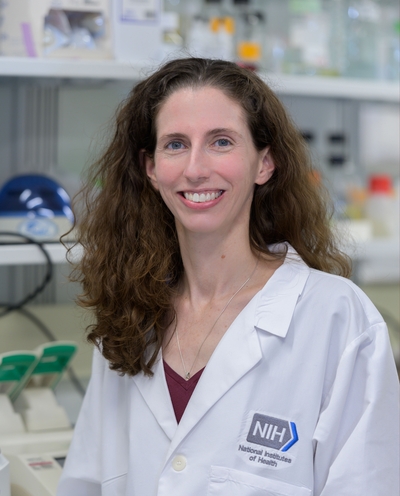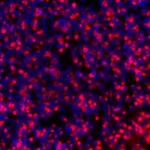
Erin L. Davies, Ph.D.
Stadtman Investigator
Cancer and Developmental Biology Laboratory
NCI/CCR
Research Topics
The Davies laboratory aims to determine the mechanisms underlying embryonic establishment of lifelong regenerative abilities in freshwater and marine flatworms. Our primary research organisms include the free-living freshwater planarians Schmidtea mediterranea and Schmidtea polychroa, and the marine flatworm Macrostomum lignano. These flatworms are fueled by ‘neoblasts,’ adult pluripotent somatic stem cells that support tissue homeostasis, regeneration, and even reproduction. We employ molecular, reverse genetic, transgenic, and -omic approaches to determine how neoblasts are specified during embryogenesis, and how somatic tissue development impacts neoblast regulation, behavior, and acquisition of regenerative abilities.
The Davies lab is soliciting applications from post-baccalaureate and post-doctoral candidates for full-time, fully funded research positions. Candidates should contact Dr. Davies (erin.davies@nih.gov) to discuss training opportunities and research projects.
How are adult pluripotent stem cells specified during planarian embryogenesis?
Planarians, like mammals, are direct developers: they construct the adult body plan during embryogenesis. Like mammalian epiblast cells, planarian embryonic pluripotent stem cells (PSCs) give rise to all adult tissues. While potency of mammalian epiblast descendants diminishes rapidly following uterine implantation, embryonic pluripotency networks remain active in planarian adult PSCs throughout life, fueling tissue homeostasis and regeneration.
We are deciphering the molecular mechanisms underlying the embryonic-to-adult pluripotency transition during planarian embryogenesis. As a first step towards this goal, we are defining embryonic and adult PSCs in Schmidtea mediterranea embryos using molecular and functional criteria. Our published data suggest that cycling, piwi-1+ embryonic PSCs give rise to adult PSCs as organogenesis begins. To determine whether, and when, embryonic piwi-1+ cells begin to function as adult PSCs, we are conducting irradiation-mediated colony repopulation assays and cell transplantation experiments using staged embryonic donor cells and irradiated adult hosts.
To determine how gene expression signatures for PSC and progenitor populations change during development, we are generating single-cell RNA-Seq atlases from stages bookending the embryonic-to-adult pluripotency transition. Differential gene expression among cells from the same stage will identify biomarkers and candidate regulators of pluripotent cell states and progenitors embarking on tissue-specific differentiation programs. Cross-stage comparisons will identify candidate cell-intrinsic regulators of the embryonic-to-adult pluripotency transition and will reveal changes in the PSC lineage repertoire during embryogenesis. This expression resource will facilitate the comparison of pluripotent cell populations across species and will identify differentiation trajectories for corroboration using lineage tracing and reverse-genetic approaches in vivo.
How do you build a regeneration-competent animal?
Regeneration emerges through coordinated communication between adult PSCs and surrounding tissues. The Davies lab will determine aspects of somatic tissue development required for niche formation and non-cell autonomous regulation of adult PSC behavior. Through comparison of regeneration-incompetent versus regeneration-competent embryos, we are identifying the tissues, signaling pathways and gene regulatory networks necessary to establish regenerative abilities. We have determined that position-independent, whole-body regenerative abilities are established gradually late in embryogenesis, and that development of wound-responsive anatomical system(s) may be rate-limiting for acquisition of regenerative abilities. These experiments will suggest strategies for reconstituting self-organizing regenerative responses in vitro, and for reverse-engineering regeneration in systems maintained by adult stem cells.
Macrostomum lignano, a comparative model to investigate adult stem cell biology in vivo
Macrostomum lignano (Mlig) is an ideal evolutionary and developmental counterpoint to the Schmidtea species for studying adult stem cell biology in different developmental stages and physiological contexts. We are making targeted investments in resource generation, establishment of new transgenic lines, and technology adaptation to study Mlig adult stem cell specification, regulation, and dynamics in vivo. We seek to address how stereotyped or tailored stem cell behaviors are in response to different physiological challenges, what role local and systemic environmental cues play in determining stem cell behavior, and finally to discover the genetic and molecular mechanisms that underlie invariant and adapted behaviors.
Like freshwater planarians, Mlig is capable of de novo regeneration of its reproductive system during adulthood. We have initiated studies to determine whether Mlig, like other flatworm species, undergoes inductive germ cell specification. We are determining the cellular origin(s) of male and female germline stem cells during development and adulthood, and the molecular mechanisms underpinning gonad development during different life cycle stages.
Biography
Dr. Davies is a developmental biologist with expertise in genetics, stem cells, germ cell and reproductive biology, and tissue regeneration. As a graduate student in Dr. Margaret Fuller’s lab at Stanford University, she studied how non-cell autonomous signals and cell-intrinsic determinants coordinate adult stem cell behavior in the Drosophila testis stem cell niche.
As a postdoctoral researcher with Dr. Alejandro Sánchez Alvarado at the Stowers Institute for Medical Research, Dr. Davies pioneered molecular and functional studies of embryogenesis in the planarian flatworm, Schmidtea mediterranea, a long-lived animal with seemingly unlimited regenerative potential. Unique among well-established research organisms, planarians possess adult pluripotent stem cells required for tissue homeostasis, whole-body regeneration, and reproduction. Planarian stem cells are highly proliferative, yet planarians neither senesce nor develop cancer. As a Stadtman Investigator, Dr. Davies will leverage the understudied context of planarian embryogenesis to determine the mechanisms underlying establishment of sustained pluripotency and regeneration competence. Her lab’s work will broaden our understanding of potency regulation, growth control, tumor suppression, aging, and tissue regeneration.
Related Scientific Focus Areas
This page was last updated on Tuesday, September 2, 2025



